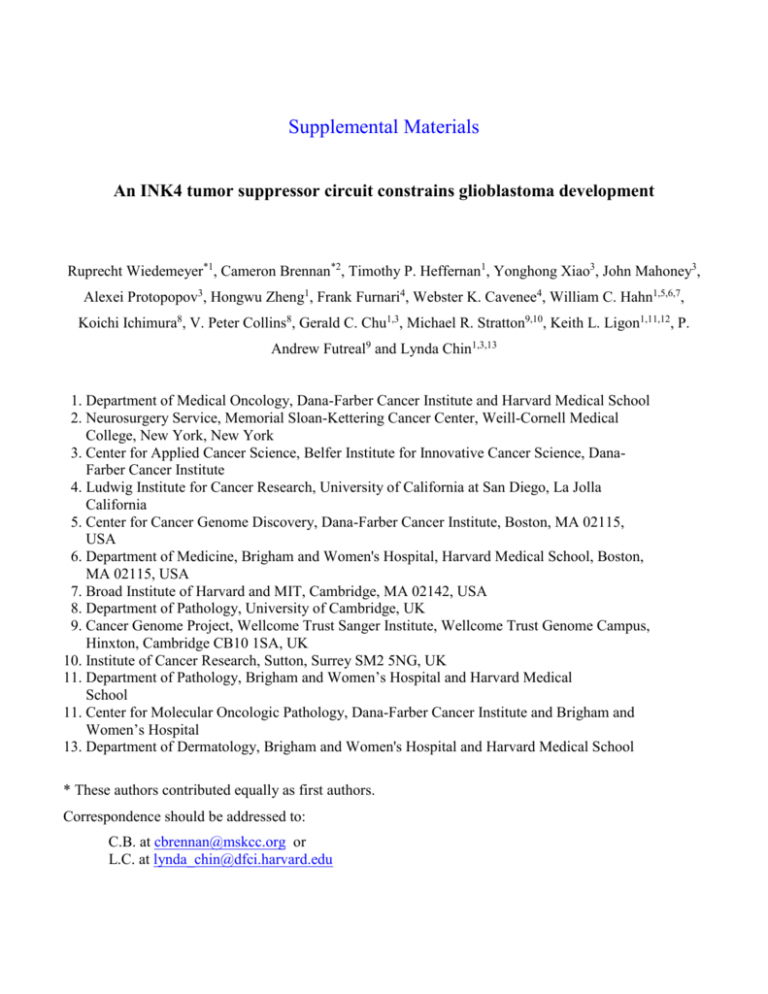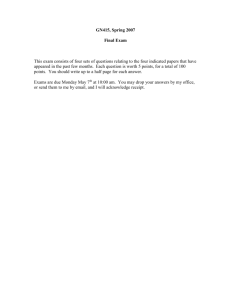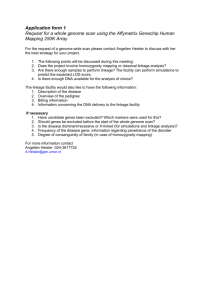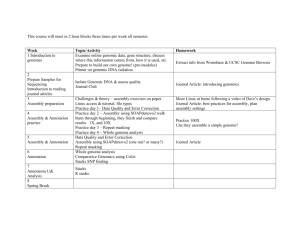Methods - Computational Biology Center at Memorial Sloan
advertisement

Supplemental Materials An INK4 tumor suppressor circuit constrains glioblastoma development Ruprecht Wiedemeyer*1, Cameron Brennan*2, Timothy P. Heffernan1, Yonghong Xiao3, John Mahoney3, Alexei Protopopov3, Hongwu Zheng1, Frank Furnari4, Webster K. Cavenee4, William C. Hahn1,5,6,7, Koichi Ichimura8, V. Peter Collins8, Gerald C. Chu1,3, Michael R. Stratton9,10, Keith L. Ligon1,11,12, P. Andrew Futreal9 and Lynda Chin1,3,13 1. Department of Medical Oncology, Dana-Farber Cancer Institute and Harvard Medical School 2. Neurosurgery Service, Memorial Sloan-Kettering Cancer Center, Weill-Cornell Medical College, New York, New York 3. Center for Applied Cancer Science, Belfer Institute for Innovative Cancer Science, DanaFarber Cancer Institute 4. Ludwig Institute for Cancer Research, University of California at San Diego, La Jolla California 5. Center for Cancer Genome Discovery, Dana-Farber Cancer Institute, Boston, MA 02115, USA 6. Department of Medicine, Brigham and Women's Hospital, Harvard Medical School, Boston, MA 02115, USA 7. Broad Institute of Harvard and MIT, Cambridge, MA 02142, USA 8. Department of Pathology, University of Cambridge, UK 9. Cancer Genome Project, Wellcome Trust Sanger Institute, Wellcome Trust Genome Campus, Hinxton, Cambridge CB10 1SA, UK 10. Institute of Cancer Research, Sutton, Surrey SM2 5NG, UK 11. Department of Pathology, Brigham and Women’s Hospital and Harvard Medical School 11. Center for Molecular Oncologic Pathology, Dana-Farber Cancer Institute and Brigham and Women’s Hospital 13. Department of Dermatology, Brigham and Women's Hospital and Harvard Medical School * These authors contributed equally as first authors. Correspondence should be addressed to: C.B. at cbrennan@mskcc.org or L.C. at lynda_chin@dfci.harvard.edu Supplemental Methods Genome-Topography-Scanning: ACGH Profile Centering: Array-CGH log2 ratios carry information about relative copy number between regions but cannot determine absolute copy number. Therefore the data must be centered to a level which is considered "functionally euploid". After CBS segmentation, "segment-smoothed" profiles are generated by replacing the raw log2 ratio at each probe location with the mean of all neighboring probes in the same segment ( S mean ). The profiles are then individually centered by the mode of the distribution of segment-smoothed log2 ratios. Combining 44K and 244K aCGH data: 98% of the probes on the Agilent 44K array are also present on the 244K array. CBS-smoothed data acquired from the 44K array was resampled at the remaining genomic probe positions of the 244K array. Gain/Loss thresholds: After centering, the distribution of all combined segment-smoothed profiles shows a sharp central peak around zero. Gain and loss thresholds are set at +/-0.2, approximately 10 SD from the middle 50%ile of the data centered at zero. ARI score: Scores for gain and loss are calculated separately for each probe position as the absolute value of the sum of the segment-smoothed log2 ratios of all samples where the values are >0.2 or <-0.2, respectively. AFI score: Aberration Focality Index measures what proportion of the ARI score is distributed per potential target genes or other genetic elements spanned by the region. AFI is the ratio of a focalityweighted ARI to unweighted ARI (fwARI/ARI). As with ARI, AFI is calculated for each genomic position, separately for gain and loss samples. Focality weighting is performed with a conceptual model for the biological process of amplification and deletion that incorporates two fundamental aspects: (1) that CNA can progress in stage-wise fashion with progressive accumulation of extra copies associated with narrowing of the altered region, and (2) that DNA rearrangement within and across chromosomes may join nonadjacent sequence or delete intervening sequence such that a single amplicon may be include disparate genomic regions and be falsely represented as distinct CNAs in the aCGH profile. We consider three models for potential linkage of CNA across the profile: local linkage treats each group of adjacent gained (or lost) segments as part of a discrete amplicon (or deletion) implying a discrete set of target genetic elements within the CNA; chromosome linkage considers that non-adjacent CNAs within the same chromosome represent a single amplicon (or deletion) with a shared set of targets; genome linkage treats all CNA as if it belongs to a single complex amplicon (or deletion). Genome linkage is a conservative model, though not likely to be biologically accurate in most cases. Chromosomal linkage was used for the analysis in this study. Calculation of AFI is as follows: For each segment Si 1.. N to ta l in the profile of N total segments: S imean = mean log2 ratio for segment I S ielements = number of genomic elements spanned by segment genomic start/end ( or 1 if no elements are spanned) Groups of potentially linked segments, S G1 , SG2 , etc., are determined by the linkage model: Genome linkage: one group, SG , comprised of all gained (or lost) segments Chromosome linkage: 24 groups, S G1..2 4 , of all gained (or lost) segments per chromosome Local linkage: M groups, S G1..M , of contiguous gained (or lost) segments bounded by nongained segments or chromosomal ends Then for each group of segments, SGn , the N segments are ordered 1 i N by increasing Si mean . The segment focality-weighted mean, fwMean, is then calculated for each segment in the group by: Si fwMean S mean i N S j i Simean 1 elements j After all profiles have been analyzed, focality-weight ARI (fwARI) is calculated as for ARI, but using the S fwMean of each segment instead of mean log2 ratio, S mean . Then AFI=fwARI/ARI. Peak selection and ROI bounding. The dual indices ARI and AFI are determined for each point in the genome and can be used directly to select genomic regions enriched for gene targets of CNA. For the purpose of summarizing the distribution of these target-enriched regions, a heuristic algorithm was developed to select regions of interest (ROIs) bounding peaks in the product of the two indices: ARI x AFI. Local peaks in ARI x AFI score are analyzed and ROIs are bounded at falloff of 75% peak maximum, or at the minimum to the next peak, whichever is narrower. Each ROI is annotated by the mean ARI and AFI indices for the region, and sorted by the product of mean indices. ROIs are flagged if over half of the probes in the ROI lie within a region previously reported to be a copy number variation (CNV) in one of the 40 studies compiled for build hg17 in version 1 of the Database of Genomic Variants (http://projects.tcag.ca/variation/). [[ Iafrate AJ, Feuk L, Rivera MN, Listewnik ML, Donahoe PK, Qi Y, Scherer SW, Lee C: Detection of large-scale variation in the human genome. Nat Genet. 2004 Sep;36(9):949-51.]] References. 1. 2. 3. 4. 5. 6. 7. 8. 9. Ishii, N. et al. Frequent co-alterations of TP53, p16/CDKN2A, p14ARF, PTEN tumor suppressor genes in human glioma cell lines. Brain Pathol 9, 469-79 (1999). Furnari, F. B., Lin, H., Huang, H. S. & Cavenee, W. K. Growth suppression of glioma cells by PTEN requires a functional phosphatase catalytic domain. Proc Natl Acad Sci U S A 94, 12479-84 (1997). McCarroll, S. A. et al. Common deletion polymorphisms in the human genome. Nat Genet 38, 8692 (2006). Hinds, D. A., Kloek, A. P., Jen, M., Chen, X. & Frazer, K. A. Common deletions and SNPs are in linkage disequilibrium in the human genome. Nat Genet 38, 82-5 (2006). Sebat, J. et al. Large-scale copy number polymorphism in the human genome. Science 305, 525-8 (2004). Sharp, A. J. et al. Segmental duplications and copy-number variation in the human genome. Am J Hum Genet 77, 78-88 (2005). Tuzun, E. et al. Fine-scale structural variation of the human genome. Nat Genet 37, 727-32 (2005). Conrad, D. F., Andrews, T. D., Carter, N. P., Hurles, M. E. & Pritchard, J. K. A high-resolution survey of deletion polymorphism in the human genome. Nat Genet 38, 75-81 (2006). Iafrate, A. J. et al. Detection of large-scale variation in the human genome. Nat Genet 36, 949-51 (2004).








